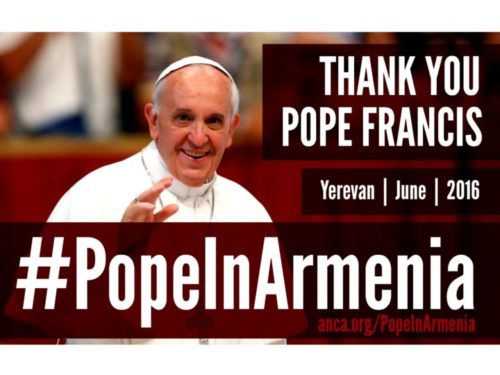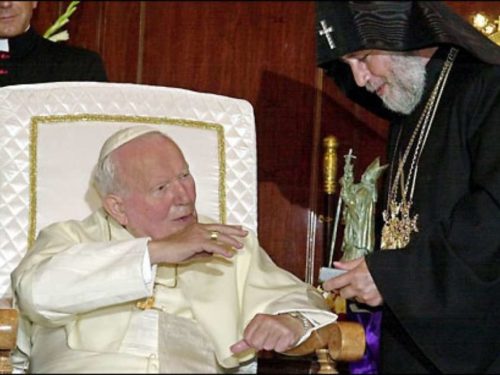Pope Francis reaffirmed the Armenian Genocide on April 12, 2015, during an unprecedented Vatican mass commemorating the 100th anniversary of that crime.
In remarks delivered at the opening of the commemorative mass, Pope Francis noted, “In the past century our human family has lived through three massive and unprecedented tragedies. The first, which is widely considered ‘the first genocide of the twentieth century’, struck your own Armenian people, the first Christian nation, as well as Catholic and Orthodox Syrians, Assyrians, Chaldeans and Greeks. Bishops and priests, religious, women and men, the elderly and even defenceless children and the infirm were murdered.”
Pope Francis went on to state that, “It is necessary, and indeed a duty, to honour their memory, for whenever memory fades, it means that evil allows wounds to fester. Concealing or denying evil is like allowing a wound to keep bleeding without bandaging it!”
Pope Francis’ knowledge and commemoration of the Armenian Genocide were nothing new. Archbishop and, later, Cardinal Bergoglio had a special relationship with the Armenian community in Argentina, according to Archbishop Kissag Mouradian, Primate of the Armenian Apostolic Church for Argentina and Chile Republic. Archbishop Mouradian explained, “On April 24 we officiated ceremonies of dirge in the Cathedral of Buenos Aires, where he always addressed his words to the Armenian people. On one of these occasions he called on Turkey to recognize his crime to enhance the relationship and doing good to the Armenian people and the Turkish people.”
The Archbishop also noted that, on the 90th anniversary of the Armenian Genocide, Cardinal Bergoglio requested the placement of a commemorative Armenian khatchkar (cross-stone) at the Metropolitan Cathedral of Buenos Aires.
While Pope Francis is the first pontiff to voice his reaffirmation of the Armenian Genocide in a prayer, Pope John Paul II had reaffirmed the Armenian Genocide on two prior occasions.
On November 9, 2000, Pope John Paul II addressed the Armenian Genocide in a joint statement with Catholicos Karekin II, spiritual leader of the Armenian Apostolic Church, following a meeting in the Vatican between the two church leaders. “For both of us, the 20th century was marked by extreme violence. The Armenian genocide, which began the century, was a prologue to horrors that would follow. Two world wars, countless regional conflicts and deliberately organized campaigns of extermination took the lives of millions of faithful,” said the statement.
Catholicos Karekin II, who was in the Vatican on a four-day visit to promote closer relations between the Armenian Church and Catholic churches, invited the Pope to Armenia next year for the 1,700th anniversary of the official declaration of Armenian Christianity. The Pope returned to Karekin II relics of Saint Gregory the Illuminator, the founder of the Armenian Apostolic Church.
On September 27, 2001, on the third day of his historic trip to Armenia marking the 1700th Anniversary of the adoption of Christianity as Armenia’s state religion, Pope John Paul II and Catholicos Karekin II issued a joint declaration, stating that “The extermination of a million and a half Armenian Christians, in what is generally referred to as the first genocide of the Twentieth Century, and the subsequent annihilation of thousands under the former totalitarian regime are tragedies that still live in the memory of the present-day generation.” It went on to note that “These innocents who were butchered in vain have not been canonized, but many among them were certainly confessors and martyrs for the name of Christ.”
Despite his strong record as a U.S. Senator and his repeated pledges as a presidential candidate to properly recognize the Armenian Genocide, President Obama has, since taking office, enforced Ankara’s gag-rule against official US commemoration of this crime – even formally opposing Congressional efforts to reaffirm past U.S. affirmation of the Genocide. The ANCA has compiled a comprehensive review of the Obama record prior to his entering the White House.
At various times over the past century, the U.S. Executive and Legislative branches have recognized the Armenian Genocide:
- Executive — The United States first officially recognized the Armenian Genocide in 1951 in a written statement to the International Court of Justice regarding the Convention on the Prevention and Punishment of the Crime of Genocide and later by President Reagan in 1981.
- Legislative — The U.S. House of Representatives adopted Armenian Genocide legislation in 1975, 1984, and reduced aid to Turkey in 1996 citing the Armenian Genocide.
- U.S. States — 44 of 50 States have recognized the Armenian Genocide through legislation or gubernatorial proclamation.
International Affirmation — 27 Countries – including 11 NATO allies – and international bodies including the European Parliament and MARCOSUR have recognized the Armenian Genocide.
The Armenian Genocide was the centrally planned and systematically executed deportation and murder of over 2 million Christian Armenians, Greeks, and Assyrians, perpetrated by the Ottoman Turkish Government from 1915-1923. Despite overwhelming documentation by historians and condemnation by over 27 countries worldwide, Turkey continues to enforce a gag-rule against truthful US reaffirmation of this crime.
ANCA Position: President Obama should honor his campaign pledge to properly recognize the Armenian Genocide and Congress should enact legislation calling for a truthful and just resolution of this still unpunished crime.


![[English Subtitles]: Pope Francis Reaffirms Armenian Genocide During Historic Vatican Mass](https://anca.org/wp-content/uploads/2016/06/youtube_nHkMeKLo_Mw-479x360.jpg)

